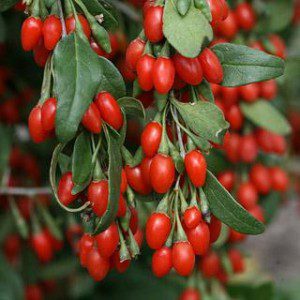Contributing Writer for Wake Up World
Goji is the darling of the berry world — exotic and nutrient dense with an antioxidant rating that is off the charts.
Over the last few years, availability of this super-berry has become more common in the Western world. But consumers and government agencies alike are questioning the safety of goji berries since the majority are grown in China — a country infamous for its lax and corrupt food safety standards. To make matters more complex, what is often touted as goji is actually a wolfberry, a similar yet different fruit.
A classic case of “buyer beware,” individuals are urged to be attentive when purchasing goji products.
Hidden dangers lurking
Due to marketing ploys and misleading information, confusion surrounds the goji berry. It is first important to understand the difference between a wolfberry and authentic Tibetan lycium goji. Often, wolfberries are labeled as goji, which is inaccurate even though the berries are similar.
Secondly, most wolfberries are grown in China, a land with very questionable organic farming practices. Even if something is labeled ‘organic’ it probably isn’t because true organic certification doesn’t exist in China. And if a product from China claims to be organically certified, “many growers simply bought the organic certificate [through illegal means],” according to Zhou Jiaqi, owner of a wolfberry exporting business. Likewise, Extending Health observes:
The Chinese version, Lycium wolfberry, has undergone many environmental, climatic and toxic changes since it was taken from Tibet thousands of years ago and cultivated in China. The Chinese botanical farms both private and commercial commonly use DDT and many other toxic chemicals (over thirty five commonly found on Chinese wolfberries) and have been for over sixty years. This has made Chinese Lycium considered unusable as a medicine or as a food source. The cultivators of Chinese Lycium – wolfberry, openly admit to using ‘controlled’ pesticides in Ningxia (the number one Chinese Lycium growing region of China).
In fact, between January 2007 and March 2009, 24 shipments of Chinese wolfberries (claiming to be goji) were refused by the the U.S. Food and Drug Administration (FDA) due to pesticide residue and other harmful impurities. Many were labeled “organic.” Unfortunately, for every shipment of contaminated wolfberries stopped at the U.S. border, plenty more manage to slip across.
Knowledge is power
True Tibetan goji is the queen of all lycium varieties. The antioxidant values (ORAC) are one of the highest of any food — helping to protect against aging, cancer and degenerative disease. Goji berries are rich in vitamins A, B and C, contain more protein than wheat and supply a variety of amino acids, including all 8 essential. The berries also support the immune system, improve eyesight, boost energy and reduce inflammation. For maximum health benefit and safety, it is best to buy from a reputable supplier who only sells goji berries specifically from Tibet. Additionally, the Tibetan Medicinal Plant Conservation Program was created to help protect the ancient art of cultivating true, organic goji.
For more information, resources are available from the Tanaduk Botanical Research Institute of Tibetan Medicine.
Sources for this article include:
http://gojiberry.com/tibetan-goji-berries-are-not-chinese-wolfberries
http://extendedhealth.com/Articles/WhereGojiBerryCameFrom
http://www.tanaduk.com/research
http://www.extremehealthusa.com/gojiarticles/gojistory
http://www.theepochtimes.com/n2/china-news/chinese-organic-exports-wear-outtheir-welcome
http://www.raysahelian.com/wolfberry
Previous articles by Carolanne:
- Kick the Caffeine Habit and Feel Better Quick with these Natural Alternatives
- Warning: Genetically Modified “Agent Orange Corn” Coming Soon to a Plate Near You
- Inspire Physical, Emotional and Spiritual Transformation with Holotropic Breathwork
- Top 10 Food Frauds: Formaldehyde, Plastic, Melamine & Caustic Soda Found in Common Foods
- Autistic Boy With Higher IQ Than Einstein Discovers Gift After Removal From State-Run Therapy
- Research Shows ‘Thunder God Vine’ Compound Annihilates Cancer in 40 days
- Turmeric Melts Away Body Fat and Defeats Insulin Resistance
- Stubborn Excess Body Fat That Won’t Budge? Yoga Can Help
About the author:
I’m Carolanne — a writer, chef, traveler and enthusiastic advocate for sustainability, organics and joyful living. It’s good to have you here. If you would like to learn more, connect with me at Thrive-Living.net or visit Twitter.com/Thrive_Living.
If you've ever found value in our articles, we'd greatly appreciate your support by purchasing Mindful Meditation Techniques for Kids - A Practical Guide for Adults to Empower Kids with the Gift of Inner Peace and Resilience for Life.
In the spirit of mindfulness, we encourage you to choose the paperback version. Delve into its pages away from screen glare and notifications, allowing yourself to fully immerse in the transformative practices within. The physical book enriches the learning process and serves as a tangible commitment to mindfulness, easily shared among family and friends.
Over the past few years, Wake Up World has faced significant online censorship, impacting our financial ability to stay online. Instead of soliciting donations, we're exploring win-win solutions with our readers to remain financially viable. Moving into book publishing, we hope to secure ongoing funds to continue our mission. With over 8,500 articles published in the past 13 years, we are committed to keeping our content free and accessible to everyone, without resorting to a paywall.








